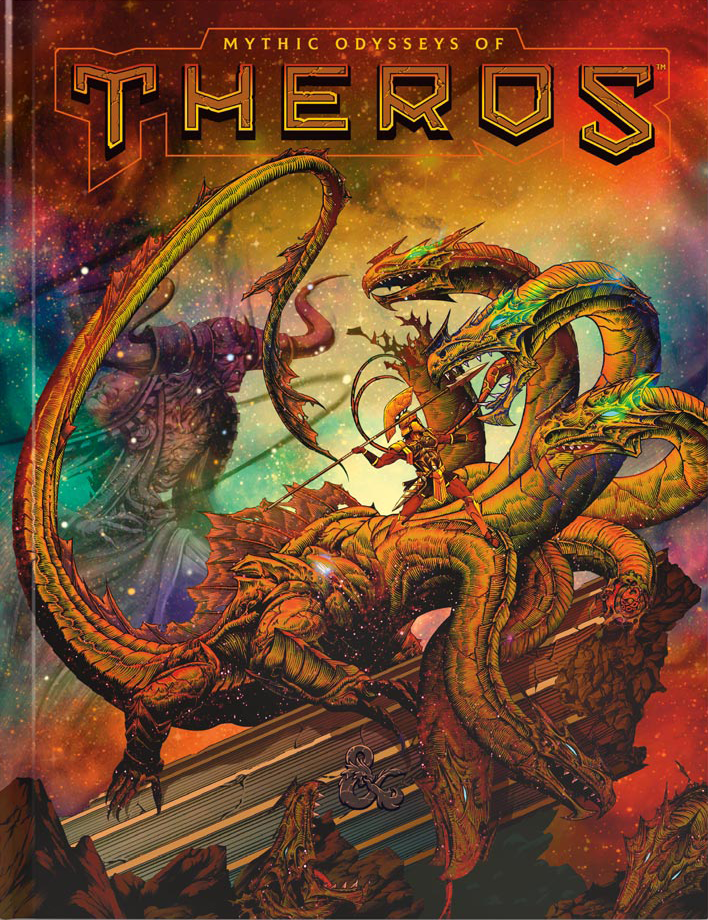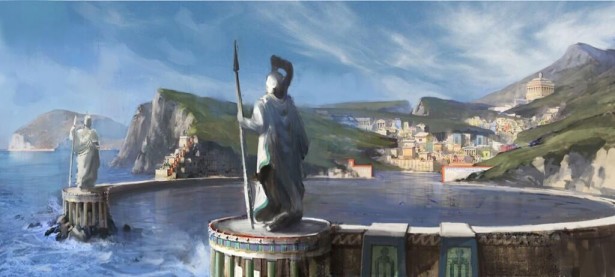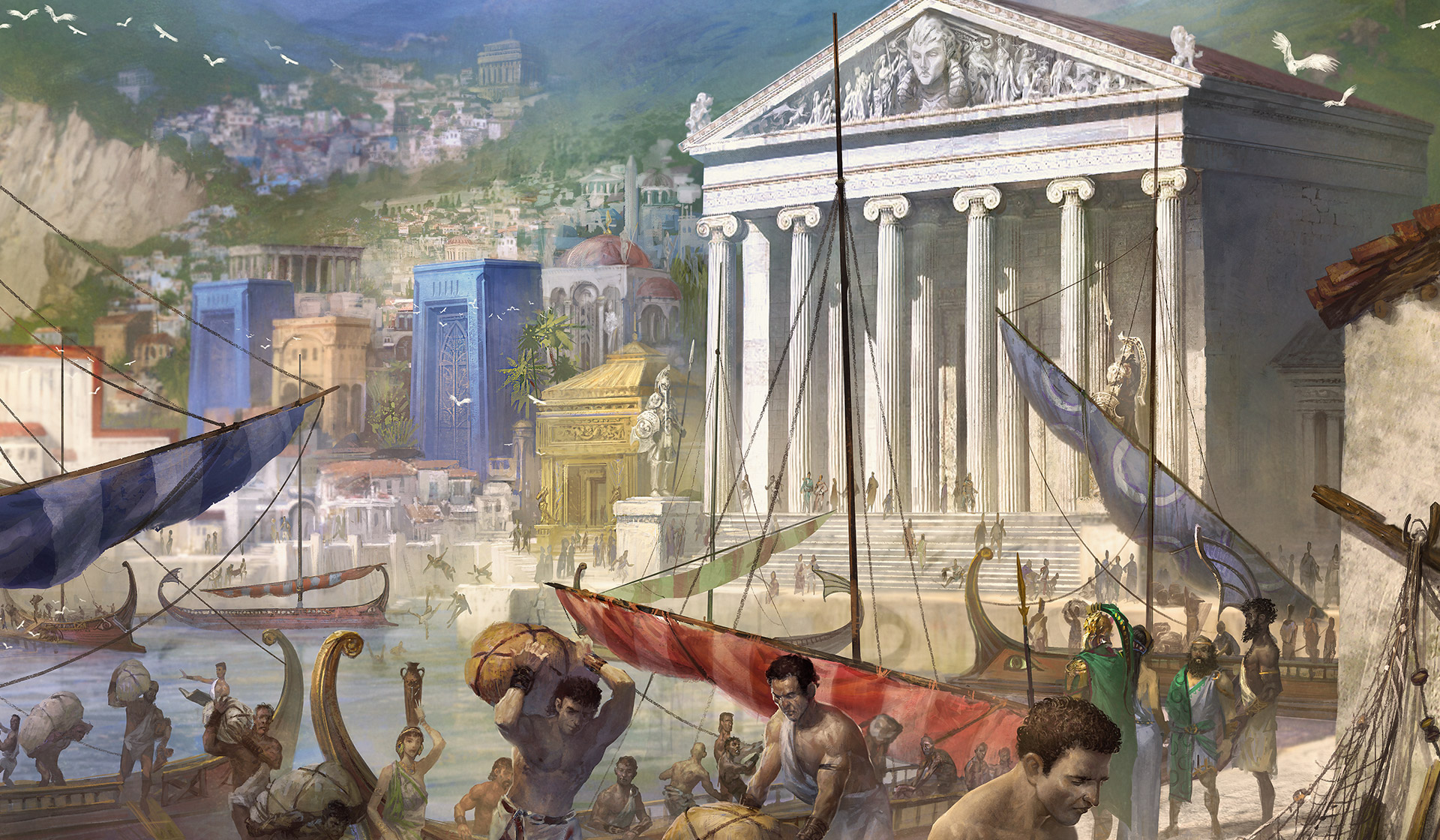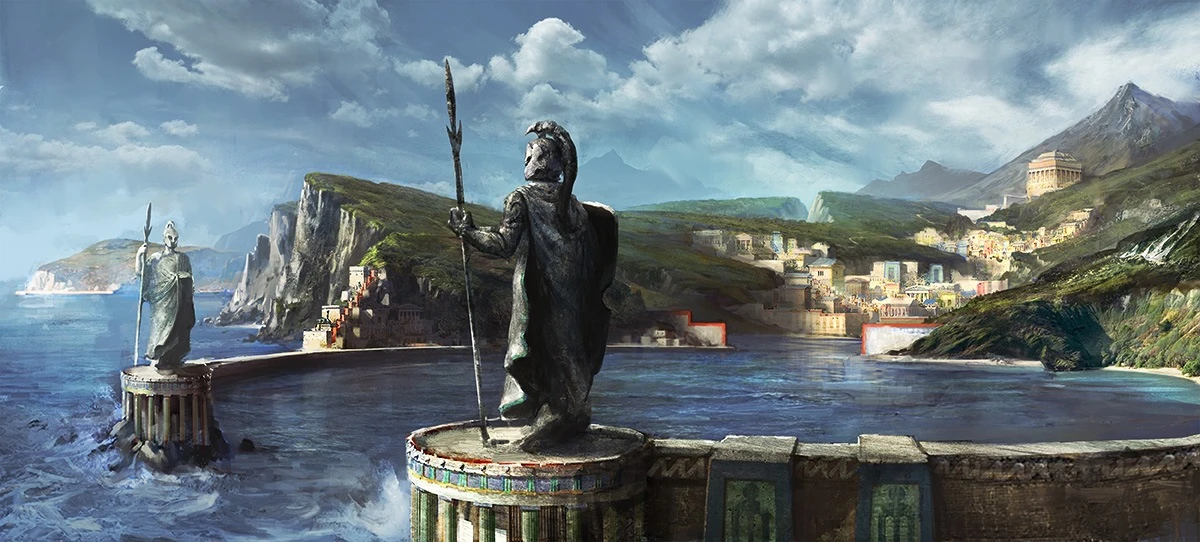Theros is a Greek-themed
campaign setting originally featured in
Magic: the Gathering, but adopted as an official D&D campaign setting in June 2020 with the hardcover book
Mythic Odysseys of Theros. The word "theros" is derived from the Greek word for "summer. The setting has a general theme of heroes vs. monsters, with city-states (Polis) based on Athens, Sparta, and Themiscira.
Mythic Odysseys of Theros
Mythic Odysseys of Theros' lead writer was James Wyatt. The maps were done by Dyson Logos. The book's release date is June 2nd, 2020. The official product description reads as follows:
Clash with the gods of Theros in this campaign sourcebook for the world’s greatest roleplaying game.
The world’s most popular roleplaying game meets the world’s most popular trading card game in this campaign sourcebook, detailing the Magic: The Gathering world of Theros for use in Dungeons & Dragons.
Legends walk the lands of Theros, a realm shaped by deities and the deeds of heroes. From the temples of omen-speaking oracles to the five realms of the Underworld, the champions of the gods vie for immortal favor and a place among the world’s living myths.
Choose a supernatural gift that sets you on the path of destiny, align yourself with one of Theros’s fifteen gods, then carve a tale of odysseys and ordeals across the domains of mortals, gods, and the dead.
What legends will you challenge—mighty heroes, inevitable prophecies, or titans imprisoned by the gods? Where will destiny and immortal schemes lead you? And what tales will you leave behind, celebrated in the pantheon of myths and writ among the eternal stars?
- Receive a supernatural gift from the gods, a set of special traits that mark your character for greatness.
- Select one of the new races for your character—such mythic peoples as the leonin or a satyr.
- New subclasses include the Bard’s College of Eloquence, masters of oratory; and the Paladin’s Oath of Glory, an affirmation of destiny laid out for you by divine providence.
- Encounter mythic monsters, creatures whose power and renown are such that their names are truly living myths. More than simply legendary, these creatures have abilities that will create a challenge fit for the gods.
- Wield god-weapons, signature items of the gods that allow your character to stand apart from other heroes. These can be a gift from your deity or perhaps you boldly stole it from them in a bid for ultimate power.
Gods
| Alternate Cover |
 |
There are 15 deities in the Theros setting, who reside in Nyx. The gods are able to take on different forms and walk among mortals. The gods also wield mythical artifacts and weapons. Of these fifteen gods, five are considered to be major gods:
- Heliod, God of the Sun (wields the Spear of Heliod)
- Thassa, God of the Sea (wields the Bident of Thassa)
- Erebos, God of the Dead (wields the Whip of Erebos)
- Purphoros, God of the Forge (wields the Hammer of Purphoros)
- Nylea, God of the Hunt (wields the Bow of Nylea)
The ten minor gods are:
- Athreos, God of Passage
- Ephara, God of the Polis
- Iroas, God of Victory
- Karametra, God of Harvests
- Keranos, God of Storms
- Kruphix, God of Horizons
- Mogis, God of Slaughter
- Pharika, God of Affliction
- Phenax, God of Deception
- Klothys, God of Destiny
Plus other former gods or divinities of lesser rank:
- Xenagos, God of Revels (the satyr who ascended to godhood and was slain by Elspeth, champion of Heliod)
- Cacophony, God of Cities (slain by Ephara, God of the Polis)
- Kestia, the Cultivator (a nymph charged by the gods to oversee the cultivation of fertile fields, crop growth, and irrigation)
Demigods
Demigods are the offspring of a god and a mortal, or a mortal raised to divine rank. There are five known demigods.
- Anax, king of Akros. Legendary warrior and tactician.
- Callaphe the Mariner, an analog of Odysseus.
- Daxos, a soldier and oracle.
- Reneta, legendary warrior, Nylea's champion.
- Tymaret, the Murder King, an undead warrior.
Piety
The Piety system from the
Dungeon Master's Guide has been expanded. Each character also gains a boon from their god, separate to
Backgrounds. Examples include having the mind of a sphinx so that your thoughts cannot be read, or being an oracle which gives the DM opportunity to include adventure hooks. James Wyatt describes the boons as "a straight power-up, but not a huge power-up". He also notes that Piety "includes all sorts of rewards and restrictions for characters who choose to devote themselves to a god and track their piety.”
History
Here are some of the major events in Theros' history.
- Reign of the Archons. Long ago a tyrannical archon empire ruled Theros, dominating with a leonine army. That empire fell, and archons these days resent that fact, often waging war on cities.
- Sealing of the Titans. Later there was a war between gods and titans. The gods won, and the titans were sealed in the underworld. Clothys, the god of fate, agreed to guard them.
- Fall of Xenagos. A satyr named Xenagos desired to ascend to godhood. He attacked cities with monstrous armies, and managed to ascend during a minotaur siege. He was taken down by a group of heroes.
- War of the Gods. A war between the gods caused the underworld to open. The titans escaped.
Places
Realms
The setting is divided into three realms:
- Nyx. The sky, dream realm, where the gods live.
- The Underworld. Where the dead go; governed by Erebos. Divided into regions, including Phylias ("a wretched and tedious realm of the uninspired"); Ilysia ("a protected realm, tranquil and vibrant"); and Tizerus, outside Erebos' palace.
- The Mortal Realm.
Five rivers, known as
The Rivers That Ring the World, divide Theros and the Underworld.
| Meletis |
 |
Poleis
The mortal realm features city states ('Poleis', singular 'Polis'). Three notable ones are:
- Meletis. An analog of Athens. A place of learning, magic and progress.
- Akros. An analog of Sparta. A warrior culture in the mountains.
- Setessa. An analog of Themiscira (the home of Wonder Woman). A city with themes of nature and family.
There are other poleis, such as the coastal Arixmethes (which Helios destroyed), Olantis (cast into the sea), the necropolises of Asphdel and Odunos, Iretis, and the minotaur polis Skophos.
Other Places
- Siren Sea. Borders Meletis; home to the tritons. Location of the Isles of Enchantment, populated by nymphs and monsters.
- Nessian Wilds. Home to centaurs, snakes, beasts, and hydras.
- Nistos Forest. Borders Setessa and the Chaparral.
- The Chaparral. Forest. Contains Skola Valley, an enchanted valley home to satrys.
- Oreskos. Main land of the leonine, ruled by Brimaz the Leonin King. Tethmos is the main leonin settlement.
Myths
There are many myths portrayed in Theros M:tG cards. These are often based on Greek mythology. Some examples are below.
- Akroan Horse (Trojan Horse)
- Chained to the Rocks (Prometheus)
- Rescue from the Underworld (Orpheus & Eurydice)
- Labyrinth Champion (Theseus)
Races
| Meletis |
 |
Theros includes the following PC races:
- Minotaurs
- Centaurs
- Merfolk (tritons from Volo's Guide to Everything). Two-legged tritons can breath air for days.
- Satyrs ("party animals with good Dexterity and Charisma, they have a headbutt attack, they're fast, they're fey, they resist magic and they have the musical instrument proficiency and persuasion" - James Wyatt)
- Leonin ("a different, stronger cat person, not just a tabaxi!" - James Wyatt). Disgraced outcasts. Come from Oreskos, ruled by Brimaz the Leonin King.
Monsters
Monsters are Greek-themed, often with revised D&D lore to match Greek origins. These include cats, centaurs, gorgons, merfolk, minotaurs, satyrs, spirits, zombies, archons, basilisks, chimeras, cyclopes, demons, dragons, giants, hags, harpies, hounds, hydras, krakens, lamias, manticores, pegasi, phoenixes, sphinxes, and sirens.
Theros includes mythic threats, which are a step up from legendary creatures. James Wyatt describes them as: "The idea behind the mythic threats is the boss fight in a computer game. This kind of monster is going to be the centerpiece of a combat encounter that goes on for longer than a couple rounds. Their abilities will be even beyond what a legendary creature does,”
One example monster is
Arasta of the Endless Web, which is "a horrible spider monster from the latest Theros
MTG set. After you’ve been fighting her for a while, all of the little baby spiders that are clinging to her abdomen come off and start fighting you as well. You have to deal with them before you can finish the job so it’s like two encounters in one.”
Links



